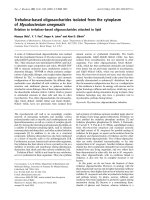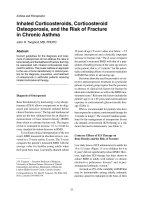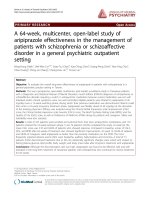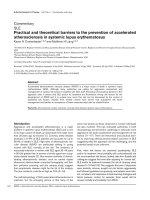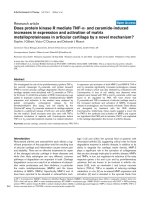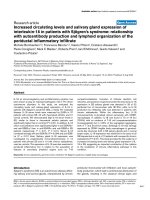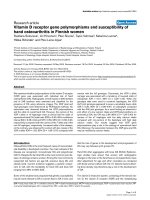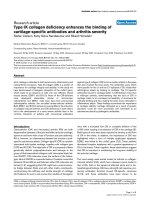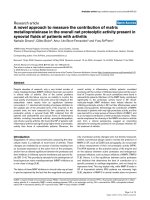Báo cáo y học: " Does psychopathology at admission predict the length of inpatient stay in psychiatry? Implications for financing psychiatric services" ppsx
Bạn đang xem bản rút gọn của tài liệu. Xem và tải ngay bản đầy đủ của tài liệu tại đây (245.42 KB, 10 trang )
RESEARCH ARTICLE Open Access
Does psychopathology at admission predict the
length of inpatient stay in psychiatry?
Implications for financing psychiatric services
Ingeborg Warnke
*
, Wulf Rössler and Uwe Herwig
Abstract
Background: The debate on appropriate financing systems in inpatient psychiatry is ongoing. In this context, it is
important to control resource use in terms of length of stay (LOS), which is the most costly factor in inpatient care
and the one that can be influenced most easily. Previous studies have shown that psychiatric diagnoses provide
only limited justification for explaining variation in LOS, and it has been suggested that measures such as
psychopathology might be more appropriate to predict resource use. Therefore, we investigated the relationship
between LOS and psychopathological syndromes or symptoms at admission as well as other characteristics such as
sociodemographic and clinical variables.
Methods: We considered routine medical data of patients admitted to the Psychiatric University Hospital Zurich in
the years 2008 and 2009. Complete data on psychopathology at hospital admission were available in 3,220
inpatient episodes. A subsample of 2,939 inpatient episodes was considered in final statistical models, including
psychopathology as well as complete datasets of further measures (e.g. sociodemographic, clinical, treatment-
related and psychosocial variables). We used multivariate linear as well as logistic regression analysis with forward
selection procedure to determine the predictors of LOS.
Results: All but two syndrome scores (mania, hostility) were positively related to the length of stay. Final statistical
models showed that syndromes or symptoms explained about 5% of the variation in length of stay. The inclusion
of syndromes or symptoms as well as basic treatment variables and other factors led to an explained variation of
up to 25%.
Conclusions: Psychopathological syndromes and symptoms at admission and further characteristics only explained
a small proportion of the length of inpatient stay. Thus, according to our sample, psychopathology might not be
suitable as a primary indicator for estimating LOS and contingent costs. This might be considered in the
development of future costing systems in psychiatry.
Background
Industrialised countries are subject to high health care
expenditure [1]. This particularly affects Switzerland,
which is second in health costs after the US. In 2007, psy-
chiatric hospitals spent about 2bn $ for mental health
care, which is ab out 10% of all expenditure on inpatient
treatment [2]. At present, length of stay (LOS) determines
costs because hospitals are paid on a day to day basis. LOS
is relatively long in Switzerland when compared to other
industrialised countries [3]. In 2006, the average LOS in
Swiss psychiatric hospitals was 44 days.
Duetohigheconomicpressure, the introduction of
new financing systems in inpatient psychiatry, such as
prospective payment, is of public concern, not only in
Switzerland but also in other countries. In somatic medi-
cine, Diagnosis Related Groups (DRGs) have led to a
reduction in LOS in several countries, including the US
[4]. DRGs refer to patient groups that are clinically
homogenous and that are associated with a fixed price
for treatment [5]. Patients are grouped on the basis of
variables that are commonly a vailable from hospital dis-
charge abstracts a nd that are assumed to have predictive
* Correspondence:
Department of General and Social Psychiatry, Psychiatric Universi ty Hospital,
Zurich, Switzerland
Warnke et al. BMC Psychiatry 2011, 11:120
/>© 2011 Warnke et al; licensee BioMed Central Ltd. This is an Open Access article distributed under the terms of the Creative Common s
Attribution License ( which permits unre stricted use, distribution, and reproduction in
any medium, provided the original work is properly cited.
power [6], (e.g. sociodemography, clinical characteristics
and treatment). However, the field of psychiatry is still
exempt from DRG s. In previous studies, psychiatric diag-
nosis could only explain up to 10-12% of the variation in
LOS [7-11]. Accord ingly, psyc hiatric inpatient treatme nt
is usually still paid for on the basis of daily rates. The
question thus arises whether other clinical measures
could better predict LOS in inpatient psychiatry to find
ways of modifying this cost-determining factor.
In view of the introduction of DRGs in Swiss somatic
hospitals in 2012, several pilot projects are being con-
ducted with respect to case-based (prospective) financing
in the area of Swiss psychiatry [12,13]. In 2008, the Canton
of Zurich started a project to investigate whether psycho-
pathological syndromes according to the AMDP-system
(referring to the working group on methods and docu-
mentation in psychiatry “Arbeitsgemeinschaft für Metho-
dik und Dokumentation in der Psychiatrie”) [14] assessed
at hospital admission might b e more appropriat e than
diagnosis for estimating resource consumption of psychia-
tric services. The major consideration was that the assess-
ment of psychopatho logical syndromes is descriptive and
free of theoretical considerations, whereas the validity of
psychiatric diagnoses is questionable [15,16]. Assessing
psychopathological symptoms is relatively easy for the
trained psychiatrist and represents a clinical standard.
Further, psychopathological syndromes are quantitatively
measurable regarding their degree of expression, and thus
dimensional. Psychopathological syndromes describe the
status of a patient in a more sophisticated way and also
consider pathology that does not yet lead to a diagnosis.
Diagnostic categories are heterogeneous with regard to
symptomatology and do not allow for a cumulative psy-
chopathological effect [17,18]. Further, patients with a cer-
tain diagnosis such as schizophrenia may have very
different psychopathology and social constraints, which
may account for the resource consumption but is not con-
sidered in the diagnosis. Accordingly, some studies suggest
that dimensional representations of psychopathology
might be more appropriate for clinical practice than cate-
gorical ones [16,19].
Knowledge concerning the association between psy-
chopathological syndromes or symptoms and LOS is
limited. A recent pilot s tudy showed that psychopatho-
logical syndromes at hospital admission explained less
than 10% of the variation in length of stay in Swiss psy-
chiatric inpatient care [20]. However, those findings
have to be regarded as preliminary due to small sample
size and limited analyses. Moreover, it remains unclear
how much of the explained variation in LOS is due to
psychopathological symptoms, the smallest entities of
psychopathological measures, which were not investi-
gated in the previous study.
Most of the previous studies that included diagnosis,
sociodemographic and other patient-variables explained
up to 20% of the variation of the LOS [21]. Variables that
significantly increased the amount of explained variation
or that were considered to be important determinants of
LOS were for instance: type of ad missio n [9], com orbid-
ity, severity of illness [22] or level of functioning [22].
The amount of expl ained variation in LOS attained more
than 20% in studies consider ing process-oriented vari-
ables like complications during hospitalisation and treat-
ment factors [21,23].
The main objective of this study was to investigate
whether psychopathology at admission (syndromes and
symptoms) as assessed by the AMDP-system was suita-
ble to predict the LOS by considering 3220 inpatient
episodes. In this respect, our study adds on a previous
investigation on syndromes and LOS that considered
only a small sample [20]. Further, we considered other
routinely collected variables that are usually mentioned
asbasicgroupingcriteriaofDGRsorarecitedassome
of the most relevant predictor variables of LOS in the
literature (e.g. sociodemography, treatment-related or
further clinical data). We were primarily interested in
variables assessed at hospital admission to obtain knowl-
edge about the prognostic factors of resource use (in
view of t he discussion on prospective payment) but also
considered treatment variables assessed during hospital
stay. In principal, we were interested in finding implica-
tions for future financing of inpatient psychiatry.
Methods
Catchment area and central psychiatric register
Up to the year 2009, the catchment area of the Psychia-
tric University Hospital Zurich included approximately
350,000 inhabitants (today about 465,000). The hospital
in question is one of six psychiatric institutions which
serve a defined catchment area in the canton and wh ich
treat the whole spectrum of mental health problems.
The Psychiatric University Hospital covers almost 40%
of the treatment episodes of these hospitals. All Swiss
cantons retrospectively collect patient data on sociode-
mographic variables, diagnosis according to the Interna-
tional Classification of Diseases (ICD- 10) and treatment
at hospital admission and/or discharge. Psychiatric hos-
pitals of the Canton of Zurich cover additional informa-
tion (e.g. data on psychopathology or severity of illness).
The physicians in charge asse ss all medical data on the
basis of a manual [13] and received special regular train-
ing in assessing psychopathology and functioning. The
data were anonymised prior access to the study group.
The ethical basis for the investigation, following the
declaration of Helsinki, is given by the general permis-
sion of the legal responsible authorities. The collection
Warnke et al. BMC Psychiatry 2011, 11:120
/>Page 2 of 10
of inpatient data in psychiatric hospitals was approved
by federal law.
Sample and data basis
Between 2008 and 2009 there were 5,224 hospital inpat i-
ent treatment episodes meeting specific inclusion criteria:
Age 18 years and over and length of sta y between 3 and
180 days. We were primarily interested in patients who
entered the psychiatric hospital due to acute mental
health problems with the need for treatment. Further, we
assumed that hospital stays of more than 180 days would
not necessarily be due to acute or chronic mental health
problems but to other factors (e.g. social problems). We
excluded admissions to the crisis intervention centre
with obligatory hospital stay up to a maximum of 5 days.
Complete data on AMDP were available in 3 ,220 of the
5,224 inpatient episodes, i.e. 62%. Complete data on psy-
chopathology and additionally on further medical data
were available in 2,939 (91%) of the 3,220 inpatient
episodes.
We considered several potential predictor variables:
Clinical factors were assessed at hospital admission and
included several variables on psychopatho logy measured
by the AMDP-system [14], which has been proven to be
a valid instrument for this purpose [24]. It consists of 140
symptoms of different psychopathological domains (e.g.
consciousness, fears and compulsions, affectivity, delu-
sions, or somatic problems) and 9 syndrome scores.
Examples of symptoms are “ hopelessness” or “ anxiety” .
The severity of each symptom was coded by 0 = no
symptom/mild symptom severity, and 1 = moderate to
strong symptom severity. The severity rating depends on
the intensity and duration of symptoms [14]. In our sta-
tistical analyses, we considered only data with at least
one available symptom out of all 140 symptoms. Nine
syndrome scores according to the AMDP were derived
by summing up specific symptom-scores: paranoid-hallu-
cinatory syndrome, depressi ve syndrome, psycho-organic
syndrome, manic syndrome, hostility syndrome, vegeta-
tive syndrome, apathy, compulsory syndrome, neurologi-
cal syndrome. In total, those syndromes consist of 78
symptoms ranging in raw scores between 0 and 234.
Apathy, for example, consists of 8 symptoms (cognitive
inhibition, mental retardation, circumstantial thinking,
narrowed thinking, low affectivity, affect rigidity, lethargy,
social withdrawal). Summing up the respective severity
ratings leads to a maximum syndrome score of 24. Syn-
drome data were left-skewed indicating that most of the
patients had lower scores, whereas fewer patients had
scores on the high end of the continuum. We considered
syndrome scores but also split syndromes to group data
around the median (lower syndrome score ≤ median vs.
higher syndrome score > median; see below). Addition-
ally, we used the GAF, which i s a severity rating that
assesses psychosocial functioning in daily life (e.g. work,
social relationships). The GAF scores range between 0
(poor functioning) and 100 (very good functioning). We
only considered GAF values with scores ≥ 1. The severity
of illness (0 = not to moderately ill vs. 1 = markedly to
extremely ill) was assessed by the Clinical Global Impres-
sions Scale [2 5]. Finally, we considered the presence of a
substance or personality disorder (main or secondary
diagnosis; 0 = no vs. 1 = yes) because they comprise clini-
cal and social aspects that are less susceptible for the
AMDP.
We also took into account basic treatment-related vari-
ables assessed at hospital discharge. Categories were cri-
sis intervention (action-oriented, limited time span,
coping with acute crisis), psychotherapy (widely used,
usually longer-lasting), integrated psychiatric treatment
(clinical management with diverse approaches) and social
interventions (management of daily activities). Addition-
ally, we included acute care (treatme nt in an acute ward)
as compared to specialised care, long-term care or care
due to substance disorders. Finally, we considered com-
pulsory treatment such as compulsory medical treatment
or seclusion. The treatment-related variables were coded
as dummy-variables (0 = no vs. 1 = yes). Sociodemo-
graphic variables included sex (0 = men, 1 = women), age
(as a continuous variable), marital status (0 = widowed,
divorced, separated, single vs. 1 = married), living situa-
tion (0 = in institution/homeless vs. 1 = own home) and
employment status (0 = unemployed vs. 1 = employed).
Finally, we considered admission-specific variables: way
of referral (ot her = 1 vs. self = 1), legal basis of admission
(0 = voluntary vs. 1 = compulsory), previous admission
(0 = no, 1 = yes) and health insurance status (0 = private
vs. 1 = general).
Statistical analyses
We performed several descriptive sample c omparisons:
We did a drop-out analysis by comparing the sample of
3,220 p atients finally includ ed in statistical analyses with
the sample excluded from analyses due to missing data on
AMDP (N = 2,004) in terms of basic admission-specific
patient characteristics (see table 1 also for applied statisti-
cal tests). Further, we compared the sample of N = 3,22 0
inpatient episodes with the sample that had complete data
on several predictor variables besides psychopathology
(N = 2,939) in terms of sociodemography and clinical
variables.
Preliminary analyses on predictors of the LOS were con-
ducted by the Spearman corre lation to analyse the rela-
tionship between discrete measures and the logarithmised
LOS. We used phi-statistics to examine the association
between dichotomised measures of psychopa thology and
binary LOS (≤ median vs. > median). Further, we com-
pared characteristics of one final sample (N = 3,220) in
Warnke et al. BMC Psychiatry 2011, 11:120
/>Page 3 of 10
terms of binary LOS (see table 2 also for applied statistical
tests).
For the final multivariate analyses, we only considered
predictor variables which were significantly (p < 0.05)
associated with each L OS variable in bivariate analyses.
Regarding analyses of symptoms and LOS, we were only
interested in those with correlations of at least r/r
>(±)
0.100. Multivariate analyses on psychopathology were
conducted by means of two statistical approaches: First,
we used multiple linear regression analysis to investigate
the amount of variation in LOS explained by the syn-
drome scores (sum of symptoms) or symptoms and
further patient-chara cteristics as mentioned in section
“sample and data basis”. Second, we used multivariate
logistic regression to find out about the odds ratios asso-
ciated with each syndrome as a binary variable (≤ median
vs. > median) using dichotomised LOS (LOS ≤ median
vs. > LOS) as the depende nt variable. In particular, R
2
from linear regression is more precise to identify the
amount of variation in LOS whereas odds ratios from
logistic regression are easier to interpret while describing
the association between binary LOS and other factors. In
each analysis, we used the forward selection procedure to
find out which syndrome s or symptoms best explained
the LOS. Fin ally, we computed eight m ultivariate statisti-
cal models by using linear vs. logistic regression: Two
models only included syndromes, two models only
included symptoms and additional four models either
covered syndromes or symptoms as well as sociodemo-
graphic, admission-specific and treatment-related vari-
ables. We did not include symptoms and syndromes in a
single model because some of them were correlated (see
results), which is due to the fact that some symptoms
constitute specific syndromes.
The co efficient of determination, R
2
(corrected; linear
regression)/Nagelkerke-R
2
(logistic regression), expresses
the amount of explained variation. Concerning linear
regression analysis, we back-transformed the regression-
coefficient (B) and the 95% confidence interval (95% CI)
from the log-scale to the original scale (EXP [B], EXP
[95% CI]). Concerning logistic regression analysis, we
showed effect coefficients and corresponding 95% CI
(EXP [B], EXP [95% CI]). Statistical analyses were con-
ducted by SPSS software [24].
Table 1 Characteristics of patients included in statistical analysis vs. those excluded
Variables N (%)
N = 2,004
N (%)
N = 3,220
N (%)
N = 5,224)
Sociodemography
Age (Median, IQR) 44 (59-33) **** 43 (54-32) **** 43 (56-32)
Sex, male 1109 (55.3) 1697 (52.7) 2806 (62.3)
Marital status, married 351 (18.8) 603 (19.9) 954 (19.5)
Employment status, employed 488 (26.8) 873 (27.9) 1361 (27.5)
Living situation, own home 1068 (74.2) 1958 (72.1) 3026 (72.8)
Clinical variables
Psychiatric disorder, only main diagnosis
Organic disorder (ICD-10, F0), yes 182 (9.1) **** 190 (5.9) **** 372 (7.1)
Substance disorder (ICD-10, F1), yes 444 (22.2) 728 (22.6) 1172 (22.4)
Psychotic disorder (ICD-10, F2), yes 495 (24.7) **** 946 (29.4) **** 1441 (27.6)
Affective disorder (ICD-10, F3), yes 332 (16.6) ** 642 (19.9) ** 974 (18.6)
Anxiety disorder (ICD-10, F4), yes 165 (8.2) * 324 (10.1) * 489 (9.4)
Behavioural, psychosomatic disorders (ICD-10, F5), yes 6 (0.3) 8 (0.2) 14 (0.3)
Personality disorder (ICD-10, F6), yes 148 (7.4) 245 (7.6) 393 (7.5)
Severity of illness at admission, markedly to extremely ill 1446 (80.2) **** 2176 (70.4) **** 3622 (74.0)
Psychosocial Functioning (Median, IQR)
§
45 (55-35) 45 (56-33) 45 (55-33)
Severity of illness at discharge (improvement during hospital stay), unchanged to extremely worse 228 (13.2) 381 (12.8) 609 (12.9)
Length of stay
†
21 (42-9) * 23 (45-10) * 22 (44-10)
Abbreviations: IQR = interquartile range. * p < 0.05, * * p < 0.01, **** p < 0.0001.
Sample comparisons were done by the Chi-Square Test.
†
Sample comparison was done by the T-Test.
§
Sample comparison was done by the nonparametric Mann Whitney U-Test.
Not all variables sum up to N = 3,220/N = 2,004 due to missing values as follows: 189/141 missings concerning marital status, 503/565 missings concerning living
situation, 89/184 missings concerning employment status, 127/202 missings concerning severity of illness at admission, 270/1,264 missings concerning
psychosocial functioning, 240/283 missings concerning severity of illness at discharge.
Warnke et al. BMC Psychiatry 2011, 11:120
/>Page 4 of 10
Results
Demographic characteristics
The sample characteristics of the inpatient episodes finally
included in statistical analyses are shown in tables 1 and 2.
The median age was 43 y ears. 55% of the patients were
males. A comparison of the final sample (N = 3,220)
considered in multivariate analysis and the sample not
included due to missing data on AMDP (N = 2,004)
showed some differences: We had relatively less completed
data from psycho-geriatric patients. The patients included
compared to those not included were slightly younger,
had a lower prevalence of an organic disorder, a higher
Table 2 Comparison of patients concerning LOS ≤ 23 days (median) vs. > 23 days (median)
Variables LOS ≤ median (N = 1,629) LOS > median (N = 1,591) Total
(N = 3,220)
Sociodemography
Age (Median, IQR) 40 (50-31) **** 46 (60-34) **** 43 (54-32)
Sex, male 909 (55.8) **** 788 (49.5) **** 1697 (52.7)
Marital status, married 288 (18.7) **** 315 (21.1) **** 603 (19.9)
Employment status, employed 449 (28.2) 424 (27.6) 873 (27.9)
Living situation, own home 1004 (71.6) 954 (72.5) 1958 (72.1)
Clinical variables
Psychopathological syndromes
Paranoid-hallucinatory syndrome > 0 (median), yes 488 (30.0) **** 613 (38.5) **** 1101 (34.2)
Depressive syndrome > 4 (median), yes 678 (41.6) **** 815 (51.2) **** 1493 (46.4)
Psycho-organic syndrome > 0 (median), yes 418 (25.7) **** 528 (33.2) **** 946 (29.4)
Manic syndrome > 0 (median), yes 230 (14.1) 412 (25.9) 642 (19.9)
Hostility syndrome > 2 (median), yes 202 (12.4) 122 (7.7) 324 (10.1)
Vegetative syndrome > 0 (median), yes 341 (20.9) **** 420 (26.4) **** 761 (23.6)
Apathy > 3 (median), yes 653 (40.1) **** 846 (53.2) **** 1499 (46.6)
Compulsory syndrome > 0 (median), yes 74 (4.5)* 101 (6.3)* 175 (5.4)
Neurological syndrome > 0 (median), yes 106 (6.5) *** 153 (9.6) *** 259 (8.0)
Substance disorder (ICD-10, F1), yes 602 (36.9) **** 303 (19.0) **** 905 (28.1)
Personality disorder (ICD-10, F6), yes 214 (13.1) **** 121 (7.6) **** 335 (10.4)
Severity of illness at admission,
markedly-extremely ill
984 (62.5) **** 1192 (78.5) **** 2176 (70.4)
Psychosocial Functioning (Median, IQR) 49 (60-35) **** 44 (55-30)**** 45 (56-33)
Severity of illness at discharge (improvement during hospital
stay), unchanged to extremely worse
283 (18.2) **** 98 (6.9) **** 381 (12.8)
Admission-specific variables
Type of referral, self 456 (30.2) **** 311 (22.8) **** 767 (26.7)
Insurance type, public 1571 (96.4) **** 1483 (93.2) **** 3054 (94.8)
Compulsory admission, yes 554 (34.0) 505 (31.7) 1059 (32.9)
Previous admission, yes 457(28.1) ** 374 (23.5) ** 831 (25.8)
Treatment variables
Compulsory medication, yes 65 (4.1) **** 110 (7.6) **** 175 (5.8)
Social seclusion, yes 70 (4.4) **** 111 (7.7) **** 181 (6.0)
Other compulsory interventions, yes 62 (3.9) **** 97 (6.7) **** 159 (5.3)
Crisis intervention, yes 842 (53.7) **** 293 (20.5) **** 1135 (37.9)
Psychotherapy, yes 64 (4.1) **** 167 (11.7) **** 231 (7.7)
Integrated treatment, yes 213 (13.6) **** 278 (19.5) **** 491 (16.4)
Advisory service 27 (1.7) 25 (1.8) 52 (1.6)
Abbreviations: LOS = length of stay. IQR = interquartile range. **** p < 0.0001, *** p < 0.001, ** p < 0.01 * p < 0.05.
Not all variables sum up to N = 3,2 20 due to missing values as follows: 189 missings concerning marital status, 503 missings concerning living situation, 89
missings concerning employment status, 127 missings concerning severity of illness at admission, 240 missings concerning severity of illness at discharge, 270
missings concerning psychosocial functioning, 342 missings concerning manner of referral, 197 missings concerning compulsory treatment, 225 missings
concerning most important treatment.
Warnke et al. BMC Psychiatry 2011, 11:120
/>Page 5 of 10
prevalence of psychotic, affective or anxiety disorders and
they were less severely ill at admission. Further, we found
that patients included stayed slightly longer than patients
excluded. Although this small difference was statistically
significant it was not considered to be clinically relevant.
Comparison with respect to LOS
About 49% of the patients in the final sample consid-
ered in multivariate analysis (N = 3,220) stayed longer
than 23 days (median) in psychiatric hospital. A com-
parison of this sample concerning LOS (≤ 23 [median]
vs. > 23 [median]) is provided in table 2.
Predictors of the length of stay
All but two syndrome scores (manic syndrome, hostility)
positively correlated with the length of stay (LOS) in uni-
variate analyses, regardless of the statistical approach used
(Spearman vs. phi-statistics). The correlation coefficients
ranged between r = 0.052/r
=
0.04 (c ompulsory syn-
drome) and r = 0.211/r
=
0.131 (apathy), indicati ng that
higher syndrome scores were associated with longer LOS.
A boxplot (Figure 1) provides an example of the associa-
tion between apathy (≤ median vs. > median) and LOS
mapped on a logarithmised ordinate.
For reasons of relevance, we only considered symptoms
with correlation coefficients of r/r
> (±) 0.100. Regarding
the Spearman correlation, we found that 7 symptoms ful-
filled this criterion: social withdrawal, morning
depressiveness, disturbance of vitality, cognitive inhibition,
anxiety, lethargy, ruminating. Regarding the phi correla-
tion, 4 symptoms were “significantly” associated with the
binary LOS-variable: social withdrawal, memory distur-
bance (short-term), morning depressiveness, memory dis-
turbance (long-term). All these symptoms were positively
related to LOS, which means higher scores were related to
longer inpatient treatment. Most of the remaini ng symp-
toms with correlation coefficients ≤ r
=
0.100 were also
positively related to LOS.
In the final statistical models conducted by linear regres-
sion, we did not consider the depressive syndrome because
it was correlated with apathy (r = 0.501, N = 3,220; r =
0.503, N = 2,939), thus the respective results on apathy
and LOS are comparable to those with the depressive syn-
drome and LOS (the latter results are not shown). Further,
we did not include the GAF score because it was corre-
lated with the CGI score (r = -0.504; N = 2,939). As men-
tioned above, we did not consider symptoms and
syndromes in a single model because some of them were
correlated as well. For example, we found correlations > r/
r
0.500, N = 3220; N = 2,939) between the depressive
syndrome and the symptom disturbance of vitality or
between apathy and the symptom social withdrawal.
We examined eight multivariate statistical models
(tables 3 and 4). In the f irst model conducted by linear
regression analysis and covering syndromes, three out of
seven syndromes remained in th e statistical mo del and
exp lai ned 5% of the variat ion of the logarithmised LOS:
paranoid-halluc inatory syndrome, apathy (associated
with depressiveness) and psycho-organic syndrome
(model 1). The logistic regression model on binary syn-
drome variables revealed that 5 syndromes led to an
explained variation of at most 4% (model 2).
Regarding linear regression analysis on symptoms, we
foundthat6outof7symptomsexplained5%ofthe
variatio n of the logari thmised LOS (model 3 in tab le 3).
The corresponding model by logistic regression shows
that 4 symptoms explained almost 5% of the variation of
the LOS (model 4 in table 3). Depending on the statisti-
cal approach, social withdrawal increase d the LOS by a
factor of 1.2 to 1.6, and morning dep ressiveness
increased the LOS by a factor of 1.6 to 3. We found
that symptoms referring to apathy, the depressive or
psycho-organic syndrome remained within the statistical
models.
The final four models conducted by linear (models 5
and7)orlogisticregressionanalysis(models6and8),
including psychopathology as well as sociodemographic,
admission-specific clinical and treatment-related chara c-
teristics, eac h resulted in an explained variation of about
25% (table 4). Other variables, as gender, were not signifi-
cant and dropped o ut. With respect to psychopathology,
only apathy (model 5) or the depressive syndrome
Apath
y
> 3 (Median) (2)< / = 3 (Median) (1)
Length of stay (LOS), days
200
150
100
50
0
Figure 1 Box-Plot of the length of stay mapped on
logarithmised ordinate across the apathetic syndrome (≤ 3
[median] vs. > 3 [median]). N = 3,220. (1): length of stay (LOS) =
19 days (median), interquartile range (IQR) = 30; apathy > 3 (2): LOS
= 29 days (median), IQR = 41. Horizontal lines illustrate median and
quartiles, vertical lines illustrate minimum and maximum of the LOS:
(1): 3-171 days, (2): 3-176 days. Circles stand for outliers (values
between 1.5 IQR’s and 3 IQR’s from the end of a box), asterisks
stand for extreme values (more than 3 IQR’s from the end of a box):
(1): ≥ 84, (2) ≥ 115.
Warnke et al. BMC Psychiatry 2011, 11:120
/>Page 6 of 10
(model 6) remained in the final statistical models.
Further, symptoms that referred to ap athy or to the
depressive syndrome were finally included (models 7 and
8). As shown in table 4 admission for crisis intervention
alone explained about 15% of the variation. Crisis inter-
vention, acute care, substance abuse, compulsory admis-
sion (model 5) and pers onality disorder (models 6-8)
were negatively related to LOS, whereas psychopathologi-
cal syndromes (models 5 and 6) or symptoms (models 7
and 8), severity of illness (CGI) and psychotherapy were
positively related. The depressive syndrome increased the
LOS by a factor of 1.3 (model 6). Being more severely ill,
rec eivi ng psychothe rapy, the symptom “morning depres-
siveness” and compulsory medication increased the LOS
by a factor of 1.6 to 1.8 (models 6 and 8). Patients who
received crisis intervention, acute care or patients with a
substance or personality disorder stayed 0.3-0.8 times
less long than patients who did not receive such therapies
or who did not h ave a substance disorder (models 6 and
8). In summary, the following variables were excluded
from the final two linear regression models: sex, marital
status, paranoid-hallucinatory syndrome, vegetative syn-
drome, compulsory syndrome, neurological syndrome,
psycho-organic syndrome, insurance type, previous
admission, integrated treatment, cognitive inhibition,
anxiety. The following variables were excluded from the
final two logistic regression models: sex, marital status,
insurance type, type of ref erral, paranoid-hallucinatory
syndrome, psycho-organic syndrome, vegetative syn-
drome, apathy, memory disturbance (short-term), mem-
ory disturbance (long-term), previous admission,
integrated treatment.
Discussion
The aim of our study was to analyse whether psycho-
pathology as assessed by the AMDP-system at admission
to psychiatric hospital as well as other variables (e.g.
treatment assessed at the end of hospital stay) are suita-
ble to predict LOS. The study was conducted in the
context of the current discussion on new financing sys-
tems in Swiss psychiatry in order to gain knowledge
bearing on future expenditure.
We examined eight multivariate statistical models.
Psychiatric syndromes (models 1 and 2) or psychopatho-
logical symptoms (models 3 and 4) explained about 5%
of the variation of LOS. The consideration of syndromes
Table 3 Prediction of the length of stay of psychiatric inpatients by psychopathology (N = 3,220)
Linear regression models Logistic regression models
†
r ** EXP (B)
+
EXP (95% CI)
+
Corr.
R
2
r
**
EXP
(B)
EXP (95%
CI)
Nagelkerke
R
2
Syndrome scores Model 1 Model 2
Intercept 16.22 15.29-17.09 0.564
Apathy 0.211 1.04 1.04-1.06 0.040 0.131 1.39 1.19-1.62 0.023
Paranoid-hallucinatory syndrome 0.112 1.02 1.01-1.03 0.047 0.090 1.41 1.20-1.63 0.031
Psycho-organic syndrome 0.108 1.02 1.01-1.03 0.050 0.090 1.33 1.15-1.54 0.036
Depressive syndrome 0.096 1.36 1.16-1.59 0.042
Neurological syndrome 0.057 1.34 1.03-1.75 0.044
Symptoms Model 3 Model 4
Intercept 17.88 17.13-18.67 0.76
Social withdrawal (apathy) 0.159 1.23 1.14-1.35 0.025 0.123 1.64 1.39-1.93 0.020
Memory disturbance (short-term) (psycho-organic
syndrome)
0.104 1.43 1.10-1.86 0.033
Morning depressiveness (depressive syndrome) 0.130 1.57 1.33-1.85 0.036 0.110 2.71 1.82-3.98 0.044
Memory disturbance (long-term)
(psycho-organic syndrome)
0.103 1.51 1.11-2.03 0.047
Disturbance of vitality (depressive syndrome) 0.101 1.16 1.06-1.27 0.043
Cognitive inhibition
(apathy)
0.128 1.25 1.09-1.45 0.047
Anxious (other) 0.106 1.14 1.05-1.24 0.049
Lethargy (apathy) 0.106 1.13 1.03-1.25 0.051
Abbreviations: LOS = length of stay.
+
EXP (B), EXP (95% CI): Back-transformed regression coefficient and 95% confidence interval from the logarithmised scale to
the original scale; r = correlation coefficient (Spearman), r
= correlation co efficient (phi statistics). ** p < 0.01.
†
LOS ≤ 23 days (median) vs. LOS > 23 days (median) was used as the dependent variable. In model 2, syndrome scores were split at the median (≤ median vs.
> median): paranoid-hallucinatory syndrome > 0 (median) vs. ≤ median, yes; vegetative syndrome > 0 (median) vs. ≤ median; apathy > 3 (median) vs. ≤ median;
compulsory syndrome > 0 (median) vs. ≤ median; neurological syndrome > 0 (median) vs. ≤ median; depressive syndrome > 4 (median) vs. ≤ median.
Warnke et al. BMC Psychiatry 2011, 11:120
/>Page 7 of 10
or symptoms and f urther characteristics (models 5-8)
led to an explained variation of about 25%, with a weak
association between AMDP-psychopathology and LOS.
Apathy (model 5) or the depressive syndrome (model 6)
were the only syndromes that remained in final statisti-
cal models. Further, symptoms that were included in
model 7 or model 8 referred to the apathetic or depres-
sive syndrome. Specific admission for crisis intervention
explained about 15% of variation in LOS.
Our results enhance previous findings on the predic-
tive power of syndromes with a smaller sample [ 20], as
here psychopathological symptoms also do not allow
sufficient prediction of LOS. Other clinical variables
besides psychopathology such as substance abuse or
severity of illness at admission had a minor influence on
the length of stay as well, which is in line with previous
findings taking several hospitals in a whole catchment
area into account while controlling for the factor
Table 4 Prediction of the length of stay by psychopathology and further characteristics (N = 2,939)
Linear regression models Logistic regression models
†
EXP (B) * EXP (95% CI) * Corr. R
2
EXP (B) EXP (95% CI) Nagelkerke R
2
Syndrome scores & further characteristics Model 5 Model 6
Intercept 21.08 18.33-24.23 0.925
Crisis intervention, yes 0.53 0.49-0.56 0.158 0.29 0.24-0.34 0.152
Apathy 1.03 1.02-1.04 0.182
Acute care, yes 0.73 0.67-0.78 0.202 0.47 0.39-0.58 0.176
Substance disorder, yes 0.78 0.72-0.83 0.219 0.53 0.44-0.64 0.203
Severity of illness, moderate to severe 1.27 1.19-1.37 0.233 1.72 1.43-2.06 0.221
Age 1.01 1.00-1.01 0.238 1.01 1.01-1.02 0.232
Psychotherapy, yes 1.27 1.12-1.43 0.241 1.83 1.32-2.53 0.237
Depressive syndrome 1.30 1.10-1.54 0.240
Compulsory medication, yes 1.33 1.16-1.53 0.244 1.64 1.15-2.33 0.243
Compulsory admission, yes 0.91 0.85-0.99 0.246
Personality disorder 0.72 0.55-0.95 0.245
Symptoms & further characteristics Model 7 Model 8
Intercept 21.18 18.42-24.37 0.879
Crisis intervention, yes 0.52 0.49-0.56 0.158 0.29 0.24-0.34 0.152
Acute care, yes 0.73 0.68-0.79 0.181 0.48 0.39-0.58 0.176
Substance disorder, yes 0.78 0.73-0.84 0.202 0.54 0.45-0.65 0.203
Severity of illness, moderate to severe 1.27 1.18-1.36 0.221 1.68 1.40-2.02 0.221
Social withdrawal
(apathy), moderate to severe
1.17 1.08-1.26 0.232
Age 1.00 1.00-1.01 0.237 1.02 1.01-1.02 0.232
Social withdrawal
(apathy), moderate to severe
1.46 1.21-1.77 0.239
Disturbance of vitality (depressive syndrome), moderate to severe 1.13 1.04-1.23 0.241
Psychotherapy, yes 1.25 1.22-1.41 0.244 1.85 1.34-2.55 0.244
Compulsory medication, yes 1.31 1.13-1.49 0.247
Ruminating
(depressive syndrome), moderate to severe
1.11 1.02-1.21 0.249
Morning depressiveness (depressive syndrome), moderate to severe 1.21 1.03-1.42 0.250 1.83 1.17-2.86 0.247
Compulsory medication, yes 1.60 1.13-2.28 0.249
Lethargy
(apathy), moderate to severe
1.09 1.01-1.21 0.251
Personality disorder, yes 0.90 0.81-0.99 0.252 0.75 0.57-0.99 0.251
Abbreviations: LOS = length of stay. * EXP (B), EXP (95% CI): Back-transformed regression coefficient and 95% confidence interval from the logarithmised scale to
the original scale.
†
LOS ≤ 23 days (median) vs. LOS > 23 days (median) was used as the dependent variable. In model 6, syndrome scores were split at the median (≤ median vs.
> median): apathy > 3 (median) vs. ≤ median; depressive syndrome > 4 (median) vs. ≤ median.
Warnke et al. BMC Psychiatry 2011, 11:120
/>Page 8 of 10
“hospital ” [11]. According to a pr evious study [21,23],
the consideration of variables related to treatment
within hospital st ay led to an explained variation of
more than 20%.
One reason for the poor association between psycho-
pathology at admission and the LOS could be attributable
to its inherent characteristi cs. On the one hand, descrip-
tive and dimensional measures of psychopathology might
indeed better represent the patient’s current mental condi-
tion than diagnosis as outlined in the introduction. How-
ever, the changeability of psychopathology implies that it
could be affected by factors within and beyond inpatient
treatment, which might influence LOS. Accordingly,
changes in clinical condition might be better related to
LOS than severity of illness at hospital admission. An ear-
lier study report ed t hat grouping patients on the basis of
severity ratings that take the treatment process into
account (e.g. symptoms from admission to discharge, level
of care, response to therapy, acute symptoms at discharge)
led to an explained variation of the LOS of up to 50% [26].
Regarding clinical practice, imagining a severely manic
and/or psychotic patient with high psychopathological
scores who is rapidly remitting under adequate medication
and discharged after 10 days, also because he or she
desires this , would be an example of high scores on psy-
chopathology and a short stay. On the other hand a schi-
zophrenic patient with low acute psycho pathology but
with a disturbed social network outside, for instance
regarding appropriate accommodation, might long remain
in hospital until the necessary subsequent support is
initiated. Another example would be a patient with an
acute but rapidly remitting depressive crisis versus a
patient with a depressive personality and a complicated
course of illness including social problems.
We further conside red treatment-related variables
within hospital stay or compulsory medication which
were assessed at hospital discha rge. However, usually
physicians determine an appropriate treatment strategy
rightatthebeginningofapatient’ s hospital stay, which
could be adjusted over time in hospital. Obviously LOS is
more strongly related to a specific global treatment
approach (in this study crisis intervention or acute care)
characterised by its duration compared to clinical mea-
sures, whenever these are less well-defined categorisa-
tions susceptible to subjective estimations. There might
be further clinical or soci al factors associa ted with the
patient’s medical condition. This could refer to etiological
features of the mental disorder as heredity, childhood or
other trauma or psychosocial burden. Little is known
about the relationship between psychosocial needs [27],
chronicity of the mental illness or response to previous
treatment [27] and the LOS. The variable social support
has been considered as an important predictor of LOS in
previous studies [28].
Further, there might be factors unrelated to the patient
which influence LOS. For example, studies including orga-
nisational variables (e.g. number of staff, ward, type of hos-
pital) show an explained variation of more than 20% [21].
The inclusion of variables referring to the care system (e.g.
number of staff, contact rate in outpati ent care, sociode-
mographic structure) also led to an explained variation of
20% [29]. It is not clear how much of the variation in LOS
is due to factors like treatment philosophy of a hospital or
the physician in question or further structural variables
(e.g. waiting time before referral to another institution,
quality of outpatient care). However, such “ external ”
factors are not related to individual treatment needs.
Nevertheless, the findings mentioned give important hints
as to factors that influence LOS. Such results on predictors
might facilitate the physician’s appropriate assessment of
LOS [6].
Our results might have implications for future research
on LOS and payment in inpatient psychiatry. First, it
might be worthwhile to focus on patients with higher
apathy or depressive syndrome. There seems to be a
need for investigating (or developing) clinical measure s
that are more strongly related to clinical practice. The
consideration of more detailed information on treatment
in routine assessment could be promising. With respect
to financing, our findings suggest that psychopathology
at admission is not suitable to serve as a basis for esti-
mating resource use. Another q uestion is whether
resource use could be sufficiently predicted at all. Some
alternative models to prospective costing are currently
examined. One example is the devel opment of a budget-
ing system on a da y to day basis which ta kes patient-
characteristics and treatment into account [12,30]. At
present, the Canton of Zurich is investigating whether
mixed financing (combining da ily rates and case-based
remuneration) might be ef fective in reducing LOS and in
preventing early readmissions [12].
We have to consider some limitations. The included
sample contained relatively less patients from the psy-
cho-geriatric wards than the excluded sample but a
slightly higher proportion of patients with an affective or
psychotic disorder, whenever the proportion of diagnoses
between both samples was still of a comparable magni-
tude. We consider this limitation to be a minor one,
because the assessed question on psychopathology and
LOS presumably does not depend on such small differ-
ences concerning case mix, all the more as LOS and diag-
nosis are not strongly related [11]. Such, our results are
to be regarded as valid for a case mix as can be found in
general psychiatric hospitals with adult psychiatric
patients. Further, data on validity or reliability of the clin-
ical ratings are not available. H owever, physicians did
receive special training in performing these ratings and
they were performed as well as possible in the routine
Warnke et al. BMC Psychiatry 2011, 11:120
/>Page 9 of 10
clinical setting. We used LOS as a proxy for resource
consumption b ut LOS is only one of several factors (e.g.
amount of service provision per day) that lead to costs.
Our approach to assessing treatment variables was on a
relatively unspecific level and should be made more spe-
cific if intended for assessing resource consumption.
Finally, AMDP-data are here only related to one specific
hospital (and one specific catchment area) in the whole
Canton of Zurich. To validate o ur findings, it might be
considered performing such investigations in other coun-
tries or in different healthcare systems.
Conclusions
Findings on app ropriate clinical predictors of length of
stay (LOS) w ith respect to financing inpatient psychiatry
are limited. We investigated the relationship between
psychopathological syndromes and symptoms assessed at
psychiatric hospital admission and LOS. In our sample,
we did not find AMDP-symptoms or AMDP-syndromes
to be suitable for predicting LOS. Accordingly, this does
not indicate that those factors might be an appropriate
basis for psychiatric c ost estimates. Further re search is
needed to find either variables that better predict the
LOS of inpatient episodes or alte rnati ve methodological
approaches that better explain resource consumption.
Acknowledgements
The authors express warm thanks to the reviewers for their advice and
important comments. In this respect, we are also grateful to Prof. Dr.
Christoph Lauber from the University of Liverpool for considerations
concerning method and content.
Authors’ contributions
IW, WR and UH conceived of the study and study design. WR strongly
contributed to the idea of examining psychopathology as probable
predictor variable of the LOS. UH participated in all parts of the manuscript
and coordination. IW participated in study design, carried out the statistical
analyses and drafted the manuscript. All authors worked on the manuscript
with important intellectual content and approved the final manuscript.
Competing interests
The authors declare that they have no competing interests.
Received: 23 December 2010 Accepted: 29 July 2011
Published: 29 July 2011
References
1. Country statistical profiles 2009. [ />DataSetCode=CSP2009].
2. Bundesamt für Statistik: Kosten und Finanzierung des
Gesundheitswesens. Neuchatel 2007.
3. Organization for Economic Co-operation and Development. [http://www.
oecd.org].
4. Güssow J: Vergütung integrierter Versorgungsstrukturen im Gesundheitswesen:
Weiterentwicklung pauschaler Vergütungsansätze zur Förderung
prozessorientierter Strukturen unter besonderer Berücksichtigung der
Krankenhausperspektive Wiesbaden: Deutscher Universitätsverlag, GWV
Fachverlage GmbH; 2007.
5. Fischer W: Ein DRG-System für die Schweiz - Gedanken zur Modellwahl.
Competence 2004, 5:4-8.
6. Oyebode F, Cumella S, Garden C, Ninyon SB: Diagnosis-reated groups:
implications for psychiatry. Psychiatr Bull 1990, 14:1-3.
7. Phelan M, McCrone P: Effectiveness of Diagnosis-Related Groups in
predicting psychiatric resource utilization in the U.K. Psychiatr Serv 1995,
46:547-549.
8. Schumacher D, Namerow M, Parker B, Fox P, Kofie V: Prospective payment
for psychiatry - feasability and impact. NEJM 1986, 315:1331-1336.
9. Taube C, Goldman H, Lee E: Use of specialty settings in constructing
DRGs. Arch Gen Psych 1988, 45:1037-1040.
10. Taube C, Lee E, Forthofer R: DRGs in Psychiatry: An Empirical Evaluation.
Medical Care 1984, 22(7):597-610.
11. Warnke I, Rössler W: Length of stay by icd-based diagnostic groups as a
basis for the remuneration of psychiatric inpatient care in Switzerland?
SMW 2008, 138:520-527.
12. 2_Newsletter_P-TAR[1].pdf. [ />Politik/Psych/Psychfin.html].
13. Gesundheitsdirektion Kanton Zurich: PSYREC-KTR-Handbuch Zurich; 2007.
14. Arbeitsgemeinschaft für Methodik und Dokumentation in der Psychiatrie:
Das AMDP-System. Manual zur Dokumentation psychiatrischer Befunde
Göttingen: Hogrefe; 2007.
15. Kendell R: Clinical validity. Psychol Med 1989, 19:45-55.
16. Van Os J, Gilvarry C, Bale R, Horn Ev, Tattan T, White I, Murray R: A
comparison of dimensional and categorical representations of psychosis.
IK 700 group. Psychol Med 1999, 29:595-606.
17. Egli S, Riedel M, Möller H, Strauss A, Läge D: Creating a map of psychiatric
patients based on psychopathological symptom profiles. Eur Arch
Psychiatry Clin Neurosci 2009, 259:164-171.
18. Kempf L, Hussain N, Potasch J: Mood disorder with psychotic features,
schizoaffective disorder, and schizophrenia with mood features: trouble
at the borders. Int Rev Psychiatry 2005, 17:9-19.
19. Johnstone E, Crow T, Frith C, Owens D: The Northwick Park “functional”
psychosis study: diagnosis and treatment response. Lancet 1988,
ii:119-125.
20. Herwig U, Warnke I, Rössler W: Psychopathological syndromes according
to the AMDP-system as the foundation for clinical case grouping in
psychiatry. Psychiatr Prax 2009, 36(7):320-326.
21. Richter D: Psychiatric inpatient length of stay. An overview of methods,
influences and consequences. Fortschr Neurol Psychiatr 2001, 69(1):19-31.
22. Ashcraft M, Fries B, Nerenz D, Falcon S, Srivastava S, Lee C, Berki S, Errera P:
A psychiatric patient classification system. An alternative to diagnosis-
related groups. Medical Care 1989, 27:543-557.
23. Kluge H, Hülsmann S, Kopf A, Angermeyer M, Becker T: Stationäre
psychiatrische Behandlungsdauer. Eine statistische Analyse auf
Grundlage einer Basisdokumentation. Krankenhauspsychiatrie 2002,
13:104-110.
24. SPSS for windows 17.0. Chicago Illinois; 2009.
25. Collegium Internationale Psychiatriae Scalarum (eds.): Internationale Skalen
für Psychiatrie Weinheim: Beltz; 1986.
26. Horn S, Chambers A, Sharkley P, Horn R: Psychiatric severity of illness: A
case mix study. Medical Care 1989, 27(1):69-84.
27. English J, McCarrick R: DRGs: an overview of the issues. Gen Hosp
Psychiatry 1986, 8(5):359-364.
28. Andreas S, Dirmair J, Koch U, Schulz H: The development of a case group
concept for patients with mental diseases. Fortschr Neurol Psychiatr 2003,
71:234-242.
29. Pertile R, Donisi V, Gigoletti L, Angelozzi A, Zamengo G, Zulian G,
Ammadeo F: DRGs and other patient-, service- and area-level factors
influencing length of stay in acute psychiatric wards: the Veneto Region
experience. Soc Psychiatry Psychiatr Epidemiol 2010.
30. Fritze J: Neue Regelungen für Einrichtungen der Psychiatrie und
Psychotherapie, Kinder- und Jugendpsychiatrie sowie Psychosomatische
Medizin und Psychotherapie im Krankenhausfinanzierungsreformgesetz
(KHRG). Nervenarzt 2009, 80:485-494.
Pre-publication history
The pre-publication history for this paper can be accessed here:
/>doi:10.1186/1471-244X-11-120
Cite this article as: Warnke et al.: Does psychopathology at admission
predict the length of inpatient stay in psychiatry? Implications for
financing psychiatric services. BMC Psychi atry 2011 11:120.
Warnke et al. BMC Psychiatry 2011, 11:120
/>Page 10 of 10
